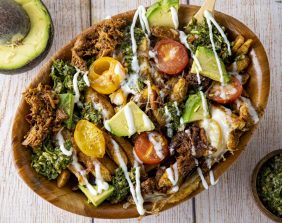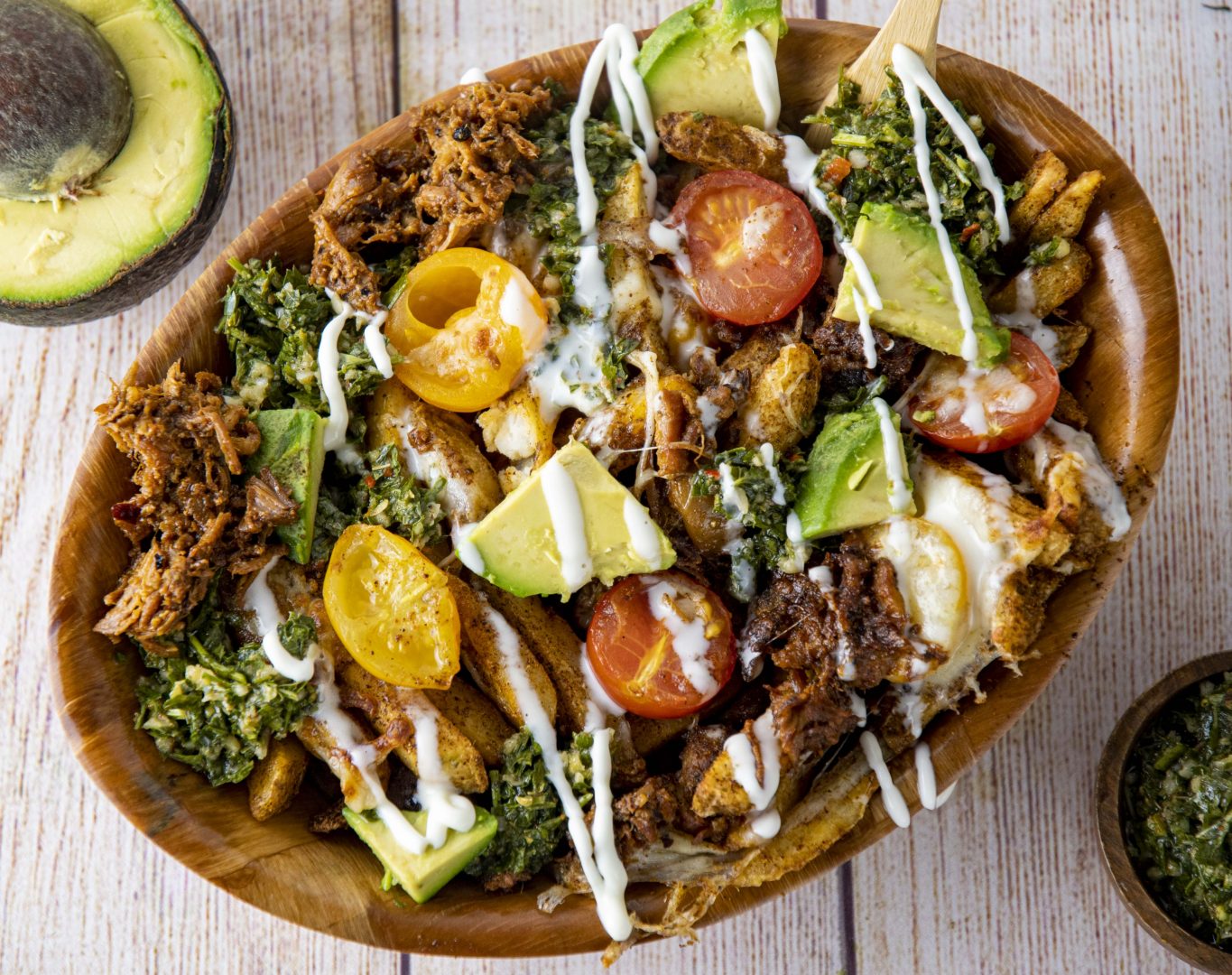Chimichurri Chilorio Cheese Fries

The history of Chimichurri
Chimichurri is a popular Sauce and Condiment that originated in Argentina. Its history can be traced back to the early 19th century, although its exact origins are subject to debate.
One theory suggests that the name “chimichurri” is derived from the Basque word “tximitxurri,” which means “a mixture of several things in no particular order.”
Quick Trivia!
This theory suggests that Basque immigrants in Argentina brought their own version of a marinade or sauce, which eventually evolved into what is known as chimichurri.
Another theory suggests that the name “chimichurri” has roots in British English. During the 19th century, British soldiers in Argentina enjoyed a sauce called “chutney curry.” The locals began to refer to the sauce as “che-mi-curry” or “chimichurri,” and over time, the name stuck.
Chimichurri gained popularity as a condiment for grilled meats, particularly beef, which is a staple of Argentine cuisine. It was traditionally made using a combination of parsley, garlic, vinegar, oil, and various herbs and spices. The ingredients are typically chopped or blended together to create a vibrant and flavorful sauce.
In Argentina, chimichurri is often served alongside asado, a traditional barbecue. It adds a burst of freshness and tanginess to the rich and smoky flavors of grilled meats. However, chimichurri is not limited to beef and can be used as a versatile sauce for various dishes, including poultry, seafood, vegetables, and even as a marinade.
Over time, different variations of chimichurri have emerged, incorporating regional ingredients and personal preferences. Some versions may include additional ingredients like oregano, cilantro, red pepper flakes, or lemon juice, which add their own unique flavors to the sauce.
Chimichurri has gained international recognition and has become a beloved condiment in many parts of the world. It is often associated with Argentine cuisine and is enjoyed by food enthusiasts globally.
Today, chimichurri continues to evolve, with chefs and home cooks experimenting with different ingredients and flavors to create their own signature versions of this delicious sauce. Its rich history and versatility have contributed to its enduring popularity as a vibrant and flavorful accompaniment to a wide range of dishes.
What can you put chimichurri on?
- Grilled steak: Chimichurri is a classic accompaniment to grilled steak, especially in Argentine cuisine. The bright and herbaceous flavors of the sauce complement the rich and savory flavors of the beef. The tanginess of the vinegar and the freshness of the herbs cut through the richness of the meat, providing a delightful contrast.
- Roasted chicken: Chimichurri adds a burst of flavor to roasted chicken. The aromatic herbs and garlic in the sauce infuse the chicken with a delicious aroma, while the tangy and zesty notes elevate the mild flavors of the poultry. Whether you’re roasting a whole chicken or chicken pieces, drizzling chimichurri over the cooked meat enhances its taste and adds a vibrant touch.
- Grilled Seafood: Chimichurri also pairs well with grilled seafood, such as shrimp, fish fillets, or scallops. The freshness of the sauce complements the delicate flavors of the seafood without overpowering them. The herbs and garlic add a pleasant herbal note, while the vinegar provides a tangy contrast. It can be used as a marinade before grilling or as a finishing sauce to drizzle over the cooked seafood.
- Roasted Vegetables: Chimichurri isn’t limited to meat-based dishes; it also adds a burst of flavor to roasted vegetables. Whether you’re roasting potatoes, carrots, zucchini, or eggplant, tossing them in chimichurri before or after roasting adds a vibrant and aromatic element. The sauce brings a herbaceous and tangy kick to the vegetables, enhancing their natural flavors and providing a fresh and zesty twist.
- Sandwiches and Wraps: Chimichurri can elevate the taste of sandwiches and wraps. Spread a layer of chimichurri on Bread.or tortillas before adding your desired fillings, such as grilled chicken, steak, or roasted vegetables. The sauce adds a zingy and herbaceous note, turning an ordinary Sandwich into a flavorful and satisfying meal.
- Grilled Portobello mushrooms: For a Vegetarian option, grilled portobello mushrooms with chimichurri make for a fantastic combination. The meaty texture of the mushrooms pairs well with the robust flavors of the sauce. The herbs and garlic in the chimichurri complement the earthiness of the mushrooms, while the acidity cuts through any richness. It’s a delicious and satisfying dish that can be served as a Main Course or a side.
In summary, chimichurri enhances a wide range of dishes by adding vibrant flavors and a fresh, tangy kick. Its versatility allows it to complement grilled meats, roasted poultry, seafood, vegetables, and even sandwiches. The combination of aromatic herbs, garlic, vinegar, and oil creates a sauce that brings out the best in various ingredients, making it a go-to condiment for many flavorful dishes.
What is the history of cheese fries?
Cheese fries, a popular Comfort Food, have a relatively more recent history compared to other traditional dishes. The exact origin of cheese fries is somewhat unclear, but they are commonly associated with American cuisine, particularly fast food and casual dining establishments.
It is believed that cheese fries originated in the United States in the mid-20th century when the popularity of both french fries and cheese began to rise. The combination of these two beloved foods seemed like a natural progression in the culinary landscape.
The exact creation of cheese fries is not attributed to a single individual or establishment. However, several regions within the United States have claimed to be the birthplace of this delectable dish. Some sources suggest that cheese fries first gained popularity in the northeastern and midwestern states, particularly in places like New York and Ohio.
In the early days, cheese fries were typically made by topping a pile of freshly fried French fries with grated or melted cheese. cheddar cheese is commonly used, but other varieties like american cheese, mozzarella, or cheese sauce are also popular choices. The fries are often baked or broiled briefly after adding the cheese to melt it.
As cheese fries gained popularity, variations and additions to the basic recipe began to emerge. Some common variations include the addition of bacon bits, green onions, jalapenos, or even chili. These additions provide extra flavor and texture, enhancing the overall taste experience.
Over time, cheese fries have become a staple at diners, fast-food chains, sports bars, and other casual dining establishments. They are often served as a Side Dish or Appetizer, and their popularity has extended to many parts of the world.
Cheese fries continue to evolve, with different regional and cultural variations being created. For example, in Canada, poutine is a popular dish that features french fries topped with cheese curds and gravy, creating a unique twist on the classic cheese fries.
Today, cheese fries are enjoyed by people of all ages and are often seen as a comforting and indulgent treat. They have become an iconic part of American fast food culture and are a common sight at events like sporting games, fairs, and movie theaters.
While the precise origin and inventor of cheese fries remain unclear, their popularity and deliciousness have made them a beloved and widely enjoyed dish across the United States and beyond.
Ingredients
- 340 g Oaxaca Cheese or mozzarella
- 750 g french fries
- 1 1/2 cup Mint Chimichurri
- 6 large cherry tomato
- 1/2 large avocado sliced
- 1 tbsp chili powder
- 1 tbsp paprika
- 1/2 tbsp cumin
- 1/4 cup crema or low fat sour cream, optional
- 600 g chilorio pork sorry no recipe- got em from a local taco joint
Instructions
- toss the fries with the spices and cook to package directions, but take them out about 4 minutes early
- Top the fries with the chilorio, cheese and tomatoes and place under broiler until cheese melted and tomatoes begin to wilt
- serve with chimichurri, avocado and crema
Nutrition





